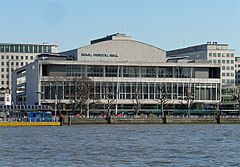Royal Festival
| Royal Festival Hall | |
|---|---|

The Royal Festival Hall from the Victoria Embankment
|
|
| General information | |
| Type | Concert hall |
| Architectural style | Modernist |
| Address | Belvedere Road London, SE1 United Kingdom |
| Coordinates | 51°30′21.01″N 00°07′00.44″W / 51.5058361°N 0.1167889°W |
| Construction started | 1948 (18 months to complete) |
| Inaugurated | 3 May 1951 |
| Renovated | 2005–2007 |
| Cost | £2 million (1951) |
| Renovation cost | £111 million (2007) |
| Client | London County Council |
| Owner |
London County Council (1951–1965) Greater London Council (1965–1986) Arts Council (1986–1988) Southbank Centre Limited (1988–present) |
| Design and construction | |
| Architect | Robert Matthew and Leslie Martin |
| Other designers | Robin Day (furniture including surviving auditorium seating) |
| Main contractor | Holland, Hannen & Cubitts |
| Website | |
| southbankcentre.co.uk | |
The Royal Festival Hall is a 2,500-seat concert, dance and talks venue within Southbank Centre in London. It is situated on the South Bank of the River Thames, not far from Hungerford Bridge, in the London Borough of Lambeth. It is a Grade I listed building, the first post-war building to become so protected (in 1981). The London Philharmonic Orchestra, the Philharmonia Orchestra and the Orchestra of the Age of Enlightenment are resident in the hall.
The hall was built as part of the Festival of Britain for London County Council, and was officially opened on 3 May 1951. When the LCC's successor, the Greater London Council, was abolished in 1986, the Festival Hall was taken over by the Arts Council, and managed together with the Queen Elizabeth Hall and Purcell Room (opened 1967) and the Hayward Gallery (1968), eventually becoming an independent arts organisation, now known as the Southbank Centre, in April 1998.
The complex includes several reception rooms, bars and restaurants, and the Clore Ballroom, accommodating up to 440 for a seated dinner. A large head and shoulders bust of Nelson Mandela (by Ian Walters, created in 1985) stands on the walkway between the hall and Hungerford Bridge approach viaduct. Originally made in glass-fibre it was repeatedly vandalised until re-cast in bronze.
...
Wikipedia
